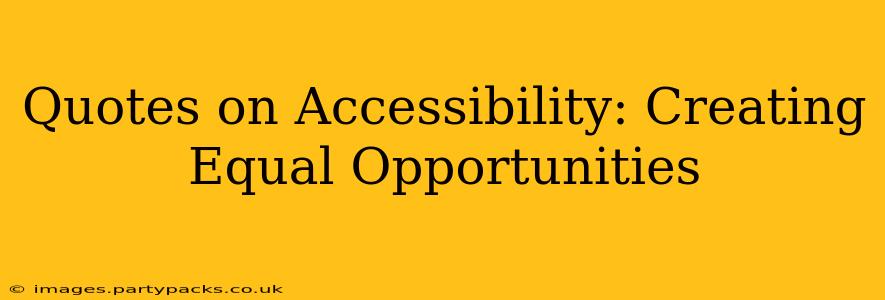Accessibility isn't just about ramps and braille; it's about creating a world where everyone can participate fully. This article explores powerful quotes on accessibility, highlighting the importance of inclusive design and the profound impact it has on individuals and society. We'll delve into the meaning behind these inspiring words and examine how they translate into practical action. By understanding the principles of accessibility, we can foster a more equitable and empowered world for all.
What is Accessibility?
Before diving into the quotes, let's establish a clear understanding of accessibility. Accessibility means designing and building environments, products, and services that are usable by people with a wide range of abilities. This includes, but is not limited to, people with disabilities relating to vision, hearing, mobility, cognition, and learning. Accessibility ensures equal opportunities, promoting inclusion and participation in all aspects of life.
Powerful Quotes on Accessibility and Inclusion
Here are some impactful quotes that capture the essence of accessibility and its importance:
-
"The measure of a society is found in how it treats its most vulnerable members." – Mahatma Gandhi. This quote emphasizes that a just and equitable society prioritizes the needs of all its citizens, including those with disabilities. Accessibility is not just a matter of convenience; it's a moral imperative.
-
"Accessibility is not a special feature; it's a fundamental right." – Unknown. This powerful statement underscores that accessibility is not an add-on but an inherent aspect of good design and social justice. Everyone deserves equal access to information, services, and opportunities.
-
"Universal design is about creating products and environments that are usable by people of all ages and abilities." – Ron Mace. Ron Mace, a pioneer in the field of universal design, highlights the importance of designing for everyone from the outset, eliminating the need for later adaptations.
-
"Disability is not a weakness; it is a diversity." – Unknown. This quote challenges the negative stereotypes associated with disability and reframes it as a source of richness and unique perspectives. Embracing diversity in its broadest sense is key to creating truly accessible environments.
Frequently Asked Questions (FAQ) about Accessibility
Here, we address some common questions related to accessibility:
What are the benefits of accessible design?
Accessible design benefits everyone. It leads to improved usability for all users, increased customer satisfaction, broader market reach, and a more inclusive and equitable society. Features designed to assist people with disabilities often improve the user experience for everyone. For example, captions benefit not only the deaf and hard of hearing but also those who watch videos in noisy environments or with the sound off.
How can businesses implement accessibility measures?
Businesses can implement accessibility measures through several means: training employees on accessibility best practices, conducting accessibility audits of their websites and physical spaces, using assistive technologies, and prioritizing inclusive design principles in the development of new products and services.
What are some examples of accessible design?
Examples include ramps and elevators (physical accessibility), alt text for images (digital accessibility), closed captions for videos, and clear and concise language in written materials (cognitive accessibility).
Is accessibility expensive to implement?
While some initial investment may be required, the long-term benefits of accessibility often outweigh the costs. Addressing accessibility issues early in the design process is typically more cost-effective than retrofitting later.
Conclusion: Embracing Accessibility for a Better Future
The quotes above eloquently capture the importance of accessibility in creating a truly equitable and inclusive society. By understanding and implementing accessibility best practices, we can create a world where everyone can participate fully, regardless of ability. Accessibility is not just a matter of compliance; it is a fundamental principle of social justice and a key ingredient for a thriving and prosperous future for all. Let's continue to strive towards a world where the potential of every individual can be realized.

